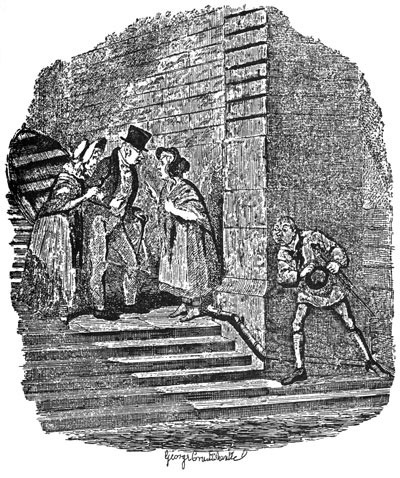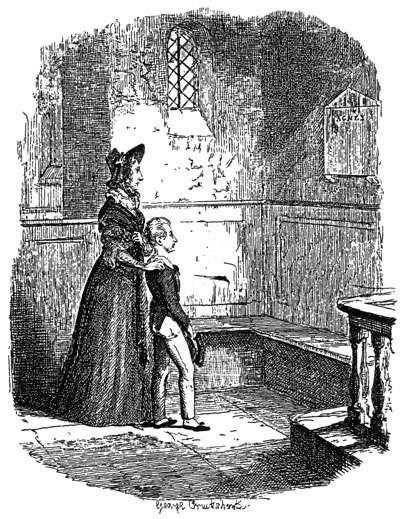The Pickwick Club discussion
In which Oliver Twist is covered
>
June 12-19, Book the Third, Chapters the 8th through the 15th (44-53)
date newest »
newest »
 newest »
newest »
message 1:
by
Jonathan
(new)
Jun 20, 2013 04:08AM
 Mod
Mod
reply
|
flag
Jonathan wrote: "Sikes attempting to destroy his dog"
Is it not strange that the dog had enough sense to run away from him, but Nancy did not? Is this biting piece of irony telling us that blind human devotion overrides our basic survival instincts so prevalent in animals?
Is it not strange that the dog had enough sense to run away from him, but Nancy did not? Is this biting piece of irony telling us that blind human devotion overrides our basic survival instincts so prevalent in animals?
 Jonathan wrote: "Fagin in the condemned cell"
Jonathan wrote: "Fagin in the condemned cell"This must be one of Cruikshank's masterpieces, just as the chapter describing Fagin's last days is one of Dickens' finest pieces of writing. So much has been written and discussed about this contradictory character, and he continues to fascinate me.
Has anyone read John Sutherland's essay "Why was Fagin hanged"? It can be found in Can Jane Eyre Be Happy?: More Puzzles in Classic Fiction. He poses the question because, at the time the story is set, being an accessory to a murder was not a hanging offence.
Pip, I think a lot of the things that Fagin and his gang did were capital offenses; for example, the housebreaking. I do think, as I noted in the first thread, that because of how Oliver's apprenticeship was handled that this was set at least 5 years earlier than it was written. Was it perhaps later in the 1830s that the laws were changed thus?
I'll look in the liner notes of my hard copy and see if there is any info on that. There is a lot of info earlier in the book about the dates that the Poor Laws changed. I should come up with something by tomorrow. Thanks for the interesting observation though.
I'll look in the liner notes of my hard copy and see if there is any info on that. There is a lot of info earlier in the book about the dates that the Poor Laws changed. I should come up with something by tomorrow. Thanks for the interesting observation though.
 Jonathan, my previous comment was a mistake on my part; of course being an accessory to murder was a hanging offence. What Sutherland pointed out in his essay was that nowhere does it say in the novel for WHAT crime he is tried. Receiving stolen goods was not something he would swing for. However, I've just found this revision of Sutherland's in which he slightly adjusts his view, without completely withdrawing the accusation possible "error" on Dickens' part:
Jonathan, my previous comment was a mistake on my part; of course being an accessory to murder was a hanging offence. What Sutherland pointed out in his essay was that nowhere does it say in the novel for WHAT crime he is tried. Receiving stolen goods was not something he would swing for. However, I've just found this revision of Sutherland's in which he slightly adjusts his view, without completely withdrawing the accusation possible "error" on Dickens' part:The other example is from Charles Dickens's 'Oliver Twist'. Why at the end of that novel is Fagin hanged? We can deduce from the whole thrust and various date-mark-
ers in the text that the narrative is set shortly after the
New Poor Law of 1834 and well after Peel's reform of the 'Bloody Code'. Fagin is not hanged for theft, or for receiving stolen goods. Dickens does not describe the process of the trial, concentrating (to brilliant effect) on the defendant's demented obsession with a broken iron spike on the railing
around the prisoner's dock.
A number of correspondents, keener-eyed than I, wrote
to point out that Fagin's accomplice Kags observes in pas- sing, some chapters earlier, that Fagin will 'swing' for abet- ting the murder of Nancy. But this still seems radically unfair. It is Claypole, not Fagin, who incites Sikes to murder. Fagin, in fact, warns Bill not to be 'too bold'. Why is Clay- pole not charged? Or Monks? Why does Fagin not testify. in his defence?
 Hello Pip,
Hello Pip,you are certainly right in saying that the novel does not give us any direct information on the crime that brings the death penalty on Fagin - at least not in chapter 52, where we would most naturally expect it.
From what I gather from Kag's words in Chapter 50 and the narrator's comments on Noah in the last chapter, I would say that Fagin is hanged for abetting the murder of Nancy, maybe in conjunction with some other crimes like the kidnapping of Oliver, but this latter idea is mere speculation on my part.
I would not find it too unfair to see Fagin as the one who turned Sikes against Nancy, because he intentionally arose Sikes's temper by asking hypothetical questions of how Sikes would treat Claypole or others if they turned traitors. So he knew what he was doing when he had Claypole tell his story to Sikes, doubtless even more than Claypole did. Fagin's warning not to be "too bold" only means that Fagin does not want Sikes to commit this murder without any prudence as to being caught; it is by no means a warning against the murder itself. Fagin actually sets Sikes up to kill Nancy. As to Monks, he may be guilty of a lot of things, but definitely he does not know anything about Sikes killing Nancy, let alone encourage this murder. He might have done so, for fear of being found out through Nancy, but as matters stood, Monks is completely ignorant of Nancy's treason.
Therefore I think that Fagin is actually as guilty of the murder as Sikes is, and that this is probably also the jury's view.
 Tristram, I absolutely agree with you that Fagin's warning not to be "too bold" is more to do with not getting caught than not killing Nancy. I also think that, from a narrative and moral point of view, Fagin had to hang. Sutherland's is an interesting point, but as we are not given details of the beginning of the judiciary process, I think we have to assume that the charge was indeed as Kags predicted - being an accessory before the crime. In that case, Claypole must have testified against him as otherwise there was no other witness to the incitement.
Tristram, I absolutely agree with you that Fagin's warning not to be "too bold" is more to do with not getting caught than not killing Nancy. I also think that, from a narrative and moral point of view, Fagin had to hang. Sutherland's is an interesting point, but as we are not given details of the beginning of the judiciary process, I think we have to assume that the charge was indeed as Kags predicted - being an accessory before the crime. In that case, Claypole must have testified against him as otherwise there was no other witness to the incitement.
 Pip wrote: "Tristram, I absolutely agree with you that Fagin's warning not to be "too bold" is more to do with not getting caught than not killing Nancy. I also think that, from a narrative and moral point of ..."
Pip wrote: "Tristram, I absolutely agree with you that Fagin's warning not to be "too bold" is more to do with not getting caught than not killing Nancy. I also think that, from a narrative and moral point of ..."Pip, I also think that being an approver - another English word I learned thanks to Dickens - would have suited Claypole admirably well. By the way, I found Dickens's way of describing the trial from Fagin's point of view, but still somehow keeping the narrator's voice clinically sober and observant of Fagin's every single thought, extremely impressive. You've already mentioned the broken iron bar, and there are lots of other details that make this scene very memorable. The same goes for Sikes's flight from the police and the remnants of his own conscience.
Scenes like these already hint at the much better novels Dickens was going to write, and yet there is also the stilted triteness of the oh so happy Oliver, Mr. Brownlow and so on. With me, all this created mixed responses.
 Fagin's guilt
Fagin's guiltI agree, Fagin is inciting Sikes. The paragraph before he says the words, "not too violent for safety" include the words,
"They [Fagin and Sikes] exchanged one brief glance; there was a fire in the eyes of both, which could not be mistaken... Fagin, showing that he felt all disguise was now useless..."
Clearly no words needed to be said on what was to be done - merely the manner and self-control needed in doing it "safely". Earlier in the chapter we had been privy to Fagin's changed views of Nancy; how he now "hated and distrusted" her.Plus, as Pip and Tristram have commented, there was a lot of preparatory build-up and incitement in the conversation with Sikes.
Bullseye
At the beginning we were told that Bullseye had "faults of temper in common with his owner". By this amusing quip Dickens makes the dog a symbolic emblem of his owner's character. He is vicious, just as Sikes has an animal-like brutality.
I was intrigued by the idea of the eyes of his victim which followed Sikes round, and the fact that his dog was named "Bullseye". At that point Bullseye had come to represent Sikes's own guilt. Sikes came to fear his dog betraying him. At first it was that Bullseye might tread bloody pawprints about. Although the dog ran away from Sikes' trying to destroy him initially, it was partly due to Bullseye being seen in his old haunts that Sikes was finally apprehended, and of course the image of Nancy's eyes continued to haunt Sikes right until the end.
I too found those books by John Sutherland interesting and would like to read them again, shortly after the relevant novels :)







